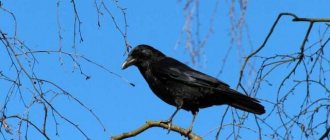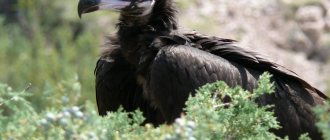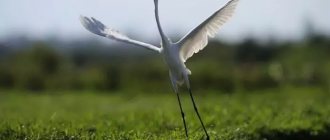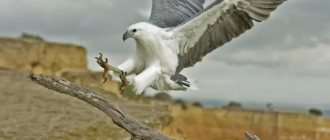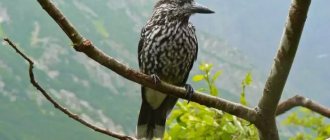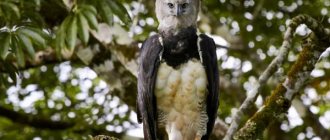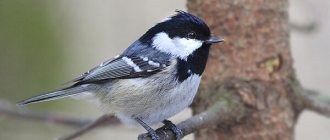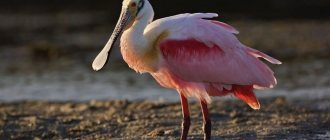The jackdaw, compared to the crow, rook and magpie, is the smallest and nimble bird (body weight up to 225 g) with modest plumage: its body is completely black and only the back and sides of the neck are covered with gray feathers.
The jackdaw, compared to the crow, rook and magpie, is the smallest and nimble bird (body weight up to 225 g) with modest plumage: its body is completely black and only the back and sides of the neck are covered with gray feathers. Length up to 25-30 cm. The most remarkable thing about the jackdaw is its eyes, the black pupil of which is surrounded by a gray-blue iris, so they appear whitish with a silvery tint.
Jackdaws are more attached to humans than crows and magpies, so they look for places for nests directly in populated areas and nest in the recesses of the eaves of houses, abandoned chimneys, chimneys of stone buildings, on bell towers, water towers and even behind store signs. Jackdaws also willingly settle in gardens and parks of large cities and small towns, making nests in the hollows of old trees. They can be found on the outskirts of forests, steep banks of river valleys, and in the mountains.
Description and features
The jackdaw is the smallest representative of the corvids. The length is the same as a pigeon: 36-41 cm. Weight corresponds to the size of the body and does not exceed 270 g. The wings open 66-75 cm. The tail is of medium length, equipped with narrower feathers than the wings.
The shape of the body, wings and tail make the birds excellent balloonists. They manage maneuverable flight. What is necessary in urban life. During long flights, jackdaws show the ability to plan and fly due to rare flaps. It is estimated that the maximum speed of which the bird is capable is 25-45 km/h.
The color scheme is typical for corvids. The main color is anthracite. The back of the head, neck, chest and back are marengo color. The same ventral part of the body. The feather fans on the wings and tail give a purple or dark blue sheen.
The beak is of medium size, but clearly designed for rough work. Half of the upper part is covered with bristles. On the lower part they occupy a quarter of the surface. Eyes change color with age. The chicks are blue. By the time of maturity, the iris of the eyes acquires a light gray, almost white color.
Sexual dimorphism is difficult to detect. In older males, the feathers on the neck and back of the head become duller and lose their shine. Even a specialist will not be able to say with confidence whether the jackdaw in the photo is a male or a female.
Chicks and young birds are more uniformly colored. The depth, saturation of tone, and the presence of color additions differ in birds living in different geographical zones. At the same time, within a flock, differences between individuals can be greater than between populations as a whole.
Jackdaws, like other corvids, have good memory, intelligence and the ability to imitate various sounds. People have long noticed this and often kept these birds at home. This was facilitated by the size of the jackdaw and its rapid adaptation to people. Currently, this is a rare hobby.
Jackdaws don't have many enemies. In the city, it is mainly crows who destroy their nests. In natural conditions, the list of enemies expands. These are carnivorous birds, feral cats and other predators that can catch a jackdaw. As with any animals that exist in close communities, manifestations of epizootics are not excluded.
Natural enemies of jackdaws
Photo: Great Jackdaw
The jackdaw is not an easy prey. This nimble, fast bird can easily hide from an enemy in the air, hide in a crack or cave, which is possible due to its small size. However, jackdaws are no less likely than other birds to become victims of natural enemies.
Among them it is worth highlighting the following:
- predator birds. Feathered predators often attack small birds of various species, and jackdaws are no exception. Eagle owls, hawks, and golden eagles are dangerous;
- crows. They also often attack members of their own family. But most often they are engaged in destroying their nests and killing chicks;
- proteins. These small animals also destroy the nests of jackdaws when they are left unattended;
- Pets. Cats and dogs eat young animals that have not yet learned to fly. This happens to chicks whose nests are located close to human habitations;
- predatory animals. Jackdaws living in the forest often become victims of foxes, wolves, and other predators;
- parasitic microorganisms, fleas, some insects, beetles.
This group of animals does not immediately lead to the death of birds and their chicks, with rare exceptions. However, they significantly undermine their health, which ultimately significantly reduces the life expectancy of jackdaws.
Kinds
The genus of jackdaws is divided into two species.
- Western jackdaw. When people talk about jackdaws, they mean this species.
- Piebald or Daurian jackdaw. A less studied variety. The habitat corresponds to the name - this is Transbaikalia and the adjacent areas. Everything that was once called Dauria.
The western jackdaw is the most studied and widespread species. Scientists have identified four subspecies of this bird. But there is no consensus among biologists.
- Coloeus monedula monedula. Nominative subspecies. The main habitat is Scandinavia. Some flocks move to England and France for the winter. Features of appearance are minor: whitish tan marks on the back of the head and neck.
- Coloeus monedula spermologus. Breeds in Europe. The darkest variety of jackdaws in color.
- Coloeus monedula soemmerringii. Lives in vast territories of Western and Central Asia, in the Trans-Urals, and Siberia. In appearance it is similar to the nominative subspecies. Sometimes experts combine this and the nominative subspecies into a single taxon.
- Coloeus monedula cirtensis. Inhabits areas of North Africa and Algeria. It differs from other jackdaws in its more uniform and dull color.
There is another bird that was classified as a jackdaw. She retained this misconception in her name: Alpine jackdaw or black jackdaw . The bird lives on the slopes of mountains in Eurasia and North Africa.
She became comfortable at an altitude of 1200 to 5000 meters above sea level. Genetic studies have led to the fact that in the biological system a separate genus was allocated for the bird, leaving it in the corvid family.
Unlike the Alpine jackdaw, the Daurian jackdaw is a direct relative of the common jackdaw. He is of the same family as her. This bird has a middle name - piebald jackdaw. She lives in Transbaikalia, in the east and north of China, in Korea.
Differs from a related species in the almost white nape, collar, chest and dark iris of the eyes. Behavior, eating habits, and attitude towards offspring are the same as those of the common jackdaw.
Where does the jackdaw live?
Photo: Black Jackdaw
Jackdaws are very common animals. They are migratory birds, so they often change their habitat depending on the climate. The natural habitat includes North Africa, Western Asia, and Europe. Common jackdaws do not live in East Asia. Instead, the east is inhabited by Daurian jackdaws, which are their closest relatives. Daurian jackdaws are very similar to common jackdaws. They have a similar appearance, almost identical voice.
Common jackdaws inhabit Europe most densely. Only in the territory of a few regions such birds cannot be found. They are not found in Finland, Scandinavia, or on some islands of the Mediterranean Sea. Jackdaw is widely represented in Ukraine and Russia. This bird lives in China, Syria, Iraq, Iran, but not everywhere.
Jackdaws are migratory, living only in the north and east of their natural habitat. With the onset of cold weather, they move to the southern regions every year. Only older birds do not fly away for the winter. They usually stay in their nesting areas. The decisive factor in this case is the presence or absence of suitable food. If there is little or no food, then the old individuals simply fly closer to people. Birds that live in France, England, Denmark, Belgium, and the Netherlands also lead a sedentary lifestyle.
Lifestyle and habitat
The question “ is the jackdaw a wintering bird or a migratory one ” is easily resolved. Like many other birds, the jackdaw combines both qualities. This is mainly a residential bird, that is, it does not make seasonal migrations.
In winter, the jackdaw remains in the same areas where it breeds chicks. But the populations that have mastered the northern regions of the range, with the arrival of autumn, gather in flocks and fly south. To Central and Southern Europe.
Migration routes are poorly understood. Jackdaws, like travelers, sometimes bring surprises. They are found in Iceland, the Faroe and Canary Islands. Daurian jackdaws fly to Hokaido and Hanshu. At the end of the 20th century, jackdaws were seen in Canada, in the province of Quebec.
Seasonal migrations cover no more than 10% of the total number of birds. But almost all groups of birds migrate. Movements may not be tied to a specific season. Most often associated with changes in the state of the food supply, the search for places favorable for nesting.
The jackdaw is a synanthropic creature. Lives and breeds chicks in populated areas. Among houses, in courtyards and in landfills they can be found in the same company as rooks. In mixed flocks, pigeons, starlings, and crows can be seen next to jackdaws.
Especially many jackdaws live in places where there are old and abandoned stone buildings. Together with crows and pigeons, they inhabited bell towers, dilapidated industrial buildings, and empty estates. The attraction to stone buildings suggests that these birds once settled on steep stone banks of rivers and mountain slopes.
When feeding together with other birds, it is almost not noticeable that the community of jackdaws is an organized group with a pronounced hierarchy. Males fight for a place in the table of ranks. The relationship becomes clear quickly. As a result of short skirmishes, the male occupies the conquered hierarchical level. His mate, the female jackdaw , turns out to be at the same level of significance.
Organization manifests itself when birds nest. The dominant couple takes the best places. The distribution of privileges among other birds occurs in accordance with a clear hierarchy. In addition to building a colony of nests, organization is manifested in defense against predators or larger contenders for the site.
Nesting sites
Jackdaws are flocking birds. They settle in one place with several families at once, forming colonies. In this way they are similar to rooks, but unlike them, they choose places with shelters for nesting. They could be:
- hollows of old trees;
- niches and crevices in rocks;
- attics of buildings, chimneys, ventilation holes under the roofs of houses;
- billboards, store signs, water towers;
- burrows, old nests of other birds.
In the wild, jackdaws live on rocky coasts, steep banks and in open forests with old trees.
Jackdaws are attached to humans and therefore often nest in populated areas. But they prefer cities with old buildings. In the same city, there will be more birds in areas with “Khrushchev” or two-story wooden houses. And in modern areas with panel and block new buildings there are no suitable places for arranging nests, so there are few jackdaws here.
Jackdaws also live in city parks and groves, finding shelter in the hollows of old trees. They often build their nests between the nests of rooks - this is how they protect their offspring from attacks by predators.
Nutrition
Omnivorousness is a quality that helps a bird to master any conditions. The protein part of the diet consists of all types of insects and their larvae, earthworms. Less than other corvids, the jackdaw pays attention to carrion. It can destroy other people's nests, steal eggs and helpless chicks.
The plant diet is varied. It includes seeds of all herbs. Agricultural grains are preferred. Do not go unnoticed: peas, acorns, berries and so on. In cities and towns, birds are attracted to places where food waste can be found.
During feeding of jackdaws, plant foods account for 20% of the feed volume, and protein foods account for 80%. The rest of the time, the proportion changes the opposite way: 80% is vegetarian food, 20% is animal food.
In search of food, jackdaws especially like to rummage through surface debris and fallen leaves. Insects are rarely caught on bushes and trees. In areas where animals are raised, their responsibility includes manure heaps. Birds can often be seen on the backs of sheep, pigs, and cows, where they free livestock from ticks and other parasites.
What does a jackdaw eat?
Photo: Galka
The jackdaw is a hardy, omnivorous bird that can adapt to almost any living conditions. This also applies to food.
The diet of such an animal includes:
- almost all varieties of small and medium-sized insects, earthworms, larvae, eggs of other birds, young chicks. It is extremely rare for jackdaws to feast on carrion, although other members of their family are very often seen eating carrion;
- grains of many agricultural crops, seeds of various types of grasses, berries, acorns, peas;
- food waste. Jackdaws have long lived in close proximity to people, so they have become accustomed to getting food for themselves in garbage dumps and landfills.
The ratio of animal and plant food changes throughout the life of birds. So, chicks eat mostly animal food. Protein allows young individuals to gain strength faster. Plant foods account for no more than twenty percent of the total diet of young animals. As you grow older, the amount of animal food decreases significantly. Adults prefer plants, seeds, and agricultural crops.
Jackdaws are often kept at home. When domesticating, it is important to feed the animal properly so that it does not get sick and can live as long as possible. The diet of a domestic jackdaw should include: small pieces of white bread, earthworms, chicken and young beef, various insects, grated carrots, cottage cheese, apple, pear, watermelon.
All food must be moistened with water. It is strictly forbidden to feed the bird sour berries, fruits or vegetables. This can lead to the death of the animal. Also, the diet of adult domesticated jackdaws must include a grain mixture. Oats, wheat, and corn are added to it.
What to pay attention to when feeding?
1. To prevent the bird from dying, you need to give it the food that is acceptable to it. Therefore, it is important to determine the type of bird. It is recommended to create a post on a bird forum or contact an ornithologist or veterinarian directly to help you select food. If the chick is an insectivorous bird, it is unable to survive on grains alone. And if it is a granivore, it will not be able to obtain enough substances necessary for its life from insects.
If no one has been able to determine what species the chick belongs to, it is worth focusing on its behavior and bowel movements. You should remember what type, color, shape and consistency the chick's droppings were on the day the bird was found. Until this time, the bird received food that was beneficial to it. You can take a photo of the chick's stool for comparison in the future.
If a chick is given food that is not intended for its species, it will constantly beg for food and will have trouble sleeping at night. His droppings will change - they will become a different color, shape and consistency. Over time, the chick may change in appearance and even die.
2. If you decide to feed the chick with porridge consisting of the ingredients listed earlier in this article, before each feeding it is advisable to prepare a clean cotton pad soaked in clean water. If a drop of porridge gets into the chick’s mouth, but onto the eye, on the head, or, even worse, on the neck, it will harden and cause suffering to the bird - scratch the skin if the drop has frozen on the plumage; or such a drop that gets on the skin will cause itching. The bird must remain clean after each feeding.
3. It is unacceptable to give the chick a large caterpillar or any other large insect so that it sticks out of the bird’s mouth. It is advisable to chop all insects so that the chick can easily swallow each piece. When feeding insects or grains, you need to give the chick a few drops of water.
4. When feeding, the chick immediately defecates. You should be prepared for this. He is capable of crap on his hand, the floor, the table, the bedspread. To prevent this from happening, it is advisable to place a paper napkin under him and only then start feeding him. The chick's feces can be easily removed with a napkin from furniture or flooring and washed off with soap and water from the hand and from any object.
5. The chick swallows about 1 cube of food at a time. Once he realizes he can't swallow it all, he backs away and swallows. You need to give him time for this - about 30 seconds or 1 minute. If he is hungry, he begins to chirp, stretch out and open his beak wide. When the chick is full, he closes his eyes and falls asleep.
6. You cannot squeeze the chick tightly so as not to break anything. For this reason, it is unacceptable to give the bird to children. They do not understand that a bird is a very fragile creature. Once in the hands of a child, the chick can receive serious injuries from which it will die in terrible agony.
7. You cannot lift the chick high above the floor. If he is active, he is able to jump out of his hands and fall to the floor. In this case, he can seriously hurt himself or even break a leg or other part of the body. The chick should be held over a soft blanket while feeding or when it needs to be examined.
Despite the fact that the overwhelming majority of bird rescuers claim that chicks need protein in large quantities, it still doesn’t hurt to be careful with ready-made food and live or frozen insects. There is especially a lot of protein in assorted dried insects. The bird's diet must be balanced - consist of a variety of nutritious foods for its species.
Does the chick need water?
Even if you feed the chick porridge (not boiled, but created using a blender), it is still recommended to give him 1-2 cubes of water at least once a day. And if the chick feeds on insects or their pieces, you should give him 0.1-0.5 cubes to drink immediately after swallowing food. If the bird refuses to drink water, you should try to pour at least a couple of drops into its beak.
The amount of water for the chick should be adjusted based on its bowel movements. If the chick's droppings are liquid, you should pour less water into its beak. If the bird's stool is not liquid enough, you need to give it more water. It is also advisable to focus on the air temperature in the room. When it's hot, the chick needs to drink more often. When it gets colder, its need for water decreases.
Is it possible to tame Magpie?
Magpies get used to hands very quickly. It is not difficult to tame them, especially if it is a chick or a young bird. Talk to your pet in a gentle voice and treat him with treats. You need to feed at the same time and gradually move closer until the magpie begins to take food from your hand.
Interesting materials:
What can be humming in a laptop? What can you upgrade in a laptop? What can you take from an old laptop? What should you check when buying a new laptop? What happens when you close the laptop lid? What is an adapter on a laptop? What is a wireless network on a laptop? What is the clipboard on a laptop? What is Fast Boot on a laptop? What is GHz in a laptop?
Reproduction
Even at a young age, birds find a partner; pairs are created once and for life. The relationship between the spouses is quite tender: the birds take care of each other and comb their feathers. You can often watch a male feeding his mate.
The mating season begins in March. In April, birds begin building nests. The nest of jackdaws is rough, flat, made of twigs, leaves, paper and rags. To strengthen it, lumps of earth and animal feces are used. The bottom of the nest is lined with soft materials: blades of grass, wool, down and feathers.
Jackdaws take a thorough approach to arranging a nest - after all, it can be used for several years. Not only males, but also females work on building a new nest or repairing an old one.
At the end of April - beginning of May, the jackdaw lays 4-7 eggs of a light blue or greenish-blue hue with brown specks. The incubation period lasts 17-20 days. The chicks that are born are naked and blind. Both parents feed the offspring. After a month, the young birds can already fly, but the couple continues to feed them for about two more weeks.
Only when young jackdaws have fully formed plumage do they begin an independent life. Birds unite in flocks, sometimes of enormous size (several hundred individuals). Jackdaws often mix with rooks.
Why does the chick scream all the time?
Every baby's cries are associated with discomfort. No baby just screams. The chick is also a baby that has its own needs. If you satisfy them, the bird will not scream around the clock:
1. The chick's reality has changed dramatically. He is scared and unpleasant that he is not in the nest, his mother, father, brothers and sisters are not nearby.
Being in warm hands calms him down.
2. The little bird calls for mom and dad.
It is advisable to take the chick in your hands and warm it with your warmth.
3. The bird is frightened by the fact that big hot hands are taking him, in front of his beak is not his mother’s beak, but a syringe or pipette.
You need to talk quietly to the bird and, lightly touching it, stroke it with the pad of your finger.
4. The bird experiences a strong feeling of hunger.
You need to feed the chick.
5. If the chick is underfed, it will begin to chirp loudly.
You need to feed him in small portions (1 cube each) with an interval of 1 minute. Usually 3-5 servings are enough for him.
6. The chick does not eat enough of what is offered to it.
On the Internet, on various sites, advice is given to make a mixture or porridge from a small piece of carrot, 1 tsp. oatmeal, 1 tsp. cottage cheese, a third of a chicken egg and 2 tsp. water. Carrots can be replaced with cucumber and cottage cheese omitted. However, both types of mixtures are not nutritious for the insectivorous chick.
Constantly feeling hungry, the bird will ask to eat at intervals of 15 minutes. It is advisable to purchase dry food. The German Claus Nestlingsfutter is considered suitable, but far from the best. If this nutritional mixture is not available, you should look in pet stores for another special food for chicks.
For our foundling we purchased Claus Nestlingsfutter. The instructions stated that the pieces of insects should be soaked in water and the mixture should be rolled into balls, which should be fed to the chick. But after soaking, no balls could be rolled. The insect pieces simply became wet.
The chick, as always, began to ask for food, received a portion of these pieces and immediately spat it out. This happened several times. Then it was decided to mix insect food with water in a blender, and add oatmeal to thicken it.
The chick really liked this porridge, and he began to ask for food less often. After feeding with such a mash, the chick's excrement became again similar to what it was when we picked it up. This means that the chick began to receive food suitable for it.
7. The chick is cold.
It is advisable to lay a soft, warm cloth with lint on the chick, and cover it with one part of it so that the head does not remain under the cloth so that the chick can breathe the air calmly. A rag with lint gives the chick the feeling that he is close to his mother. If desired, he can bury himself in the pile, like in the feathers of his parents.
8. The chick is hot.
When it is hot, the chick sleeps poorly and constantly vocalizes. He can be very fussy. Due to the high temperature, the bird may have problems with bowel movements. He will begin to push and scream. To prevent this from happening, it is recommended to place the cage with the chick in a part of the apartment where there is no direct rays of the sun (from a window or door) and heating devices: fireplace, oven, TV, computer, monitor and others.
9. The chick is bored.
It is advisable to take the bird in your arms and place it on a blanket spread on the floor so that the chick can jump. Then feed him and send him to bed. If this does not help, it is recommended to install a crossbar in the cage, secured on both sides. Already place the chick on it.
A chick sitting on a perch is easy to feed. In addition, he is able to fall asleep while sitting on the bar. But while the bird is small (not fully feathered), it is difficult for him to hold on to something with his paws for more than an hour. Therefore, you need to remove it from its perch in time.
10. Many birds tweet constantly. This is how they communicate. The little bird is able to communicate all the time.
If you make some kind of quiet sound that does not frighten the bird, this will calm the bird. For example, smack or tut. If a chick is too talkative, you will have to put up with its constant chirping.
11. Chicks react to loud and sharp sounds. After all, they scare kids.
Frightened by new sounds, the chick may scream until it is fed and placed in a warm fleece cloth. That is, until they imitate the presence of their mother.
12. If a chick needs to learn to fly, it will begin to vocalize.
It is advisable to take the bird out of the cage and let it jump on the floor so that it tries to fly. This will have to be done 3 to 5 times a day, all the time watching every movement of the chick. In order not to waste time on this, it is worth buying or building an aviary for the bird, where it will independently learn to fly.
